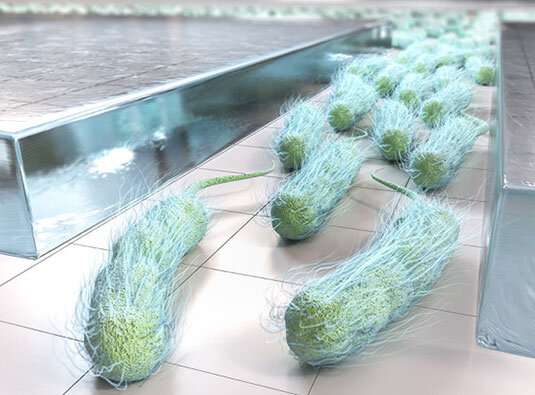The art of worming through tight spaces

How active matter, such as assemblages of bacterial or epithelial cells, manages to expand into narrow spaces largely depends on their growth dynamics, as LMU physicists demonstrate in a newly published study.
Biological forms of active matter, such as bacterial biofilms or sheets of epithelial cells, are often found in confined microspaces. Working out how such systems colonize their environment and extend their range by invading new territories will enhance our understanding of many of the normal functions and disease states observed in higher organisms. In cooperation with Dr. Amin Doostmohammadi (University of Oxford), LMU physicists Felix Kempf and Professor Erwin Frey have now demonstrated with the aid of computer simulations that cell collectives exhibit a variety of motility patterns as they approach and pass through local constrictions. The authors of the new study go on to show that the pattern adopted depends on the level of active motility that develops at the leading edge of the assemblage. The findings appear in the journal Soft Matter.
Several previous publications had suggested that the collective motions of biological matter are influenced by the nature of the terrain in which such systems find themselves. In particular, in-vitro experiments carried out with epithelial and bacterial cells, and with mixtures consisting of isolated intracellular biofilaments and molecular motors, have revealed that spatial boundaries have a significant impact on motility. "So far, this type of research has concentrated primarily on the interactions between the shape of the obstacle employed and the motile activity of the particles concerned," says Kempf, the lead author of the new paper. However, in most of these systems, the number of particles does not remain constant. Under natural conditions, epithelial or bacterial cells divide at regular intervals and, when confined in capillary tubes, they form an advancing invasion front. Therefore, in order to understand how these patterns form and evolve, it is necessary to take the growth dynamics of these systems into account. Kempf and colleagues used computer simulations to explore the effects of this factor.
They observed three fundamentally distinct modes of invasion, which can be distinguished on the basis of the overall activity of the growing system and the behavior of the invasion front as it approaches the constriction. If the level of motile activity is low, the invasion front retains its smooth and sharply defined outline as it advances at a constant speed. At higher levels of activity, the leading edge takes on an irregular outline. Finally, once the activity level exceeds a certain threshold, small clusters of cells detach from the advancing front, which can then worm their way through the narrow gap. The simulations also enabled the researchers to characterize the processes that drive the transitions observed as the invasion front evolves, and to quantify their impact on the speed with which the cells advanced into the ever more confined space. "These findings make a significant contribution to our understanding of active matter, and have several implications that can be tested in future experiments," says Kempf.
More information: Felix Kempf et al. Active matter invasion, Soft Matter (2019). DOI: 10.1039/C9SM01210A
Journal information: Soft Matter
Provided by Ludwig Maximilian University of Munich





















